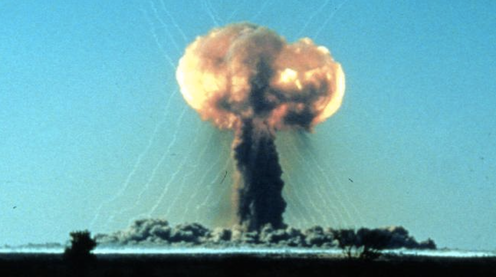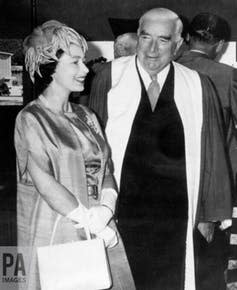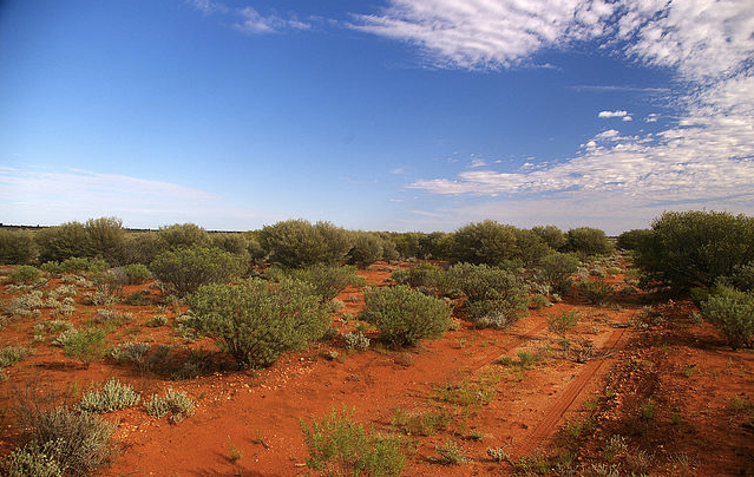Australia's nuclear testing before the 1956 Olympics in Melbourne should be a red flag for Fukushima in 2020

The scheduling of Tokyo 2020 Olympic events at Fukushima is being seen as a public relations exercise to dampen fears over continuing radioactivity from the reactor explosion that followed the massive earthquake six years ago.
It brings to mind the British atomic bomb tests in Australia that continued until a month before the opening of the 1956 Olympic Games in Melbourne – despite the known dangers of fallout travelling from the testing site at Maralinga to cities in the east. And it reminds us of the collusion between scientists and politicians – British and Australian – to cover up the flawed decision-making that led to continued testing until the eve of the Games.
Read more: Sixty years on, the Maralinga bomb tests remind us not to put security over safety
Australia’s prime minister Robert Menzies agreed to atomic testing in December 1949. Ten months earlier, Melbourne had secured the 1956 Olympics even though the equestrian events would have to be held in Stockholm because of Australia’s strict horse quarantine regimes.
The equestrians were well out of it. Large areas of grazing land – and therefore the food supplies of major cities such as Melbourne – were covered with a light layer of radiation fallout from the six atomic bombs detonated by Britain during the six months prior to the November 1956 opening of the Games. Four of these were conducted in the eight weeks running up to the big event, 1,000 miles due west of Melbourne at Maralinga.
Bombs and games
In the 25 years I have been researching the British atomic tests in Australia, I have found only two mentions of the proximity of the Games to the atomic tests. Not even the Royal Commission into the tests in 1985 addressed the known hazards of radioactive fallout for the athletes and spectators or those who lived in the wide corridor of the radioactive plumes travelling east.
At the time, the approaching Olympics were referred to only once in the Melbourne press in relation to the atomic tests, in August 1956. It is known that D-notices from the government “requesting” editors to refrain from publishing information about certain defence and security matters were issued.
The official history of the tests by British nuclear historian Lorna Arnold, published by the UK government in 1987 and no longer in print, reports tests director William Penney signalling concern only once, in late September 1956:
Am studying arrangements firings but not easy. Have Olympic Games in mind but still believe weather will not continue bad.
This official history doesn’t comment on the implications. And nowhere in the 1985 Royal Commission report is there any reference to the opening of the Olympics, just one month and a day after the fourth test took place 1,000 miles away.
The 1984 report of the Expert Committee on the review of Data on Atmospheric Fallout Arising from British Nuclear Tests in Australia found that the methodology used to estimate the numbers of people who might have been harmed by this fallout at fewer than 10 was inappropriate. And it concluded that if the dose calculations were confined to the communities in the path of the fallout and not merged with the total Australian population “such an exercise would generate results several orders of magnitude higher than those based on conventional philosophy”. There was no mention of the Olympic Games.

Neither Prime Minister Menzies nor his cabinet ever referred publicly to what had been known from the outset – that the British atomic tests in Australia would almost coincide with the Melbourne Olympics. The tests and the Games were planned simultaneously through the first half of the 1950s.
In May 1955, 18 months before the Olympics were due to start, Howard Beale, the Australian minister for supply, announced the building of “the Los Alamos of the British Commonwealth” (a nuclear test site in New Mexico) at Maralinga, promising that “tests would only take place in meteorological conditions which would carry radioactive clouds harmlessly away into the desert”.
An Atomic Weapons Tests Safety Committee was formed by the Australians but was closely controlled by physicist Professor Ernest Titterton, the only Englishman on the panel. The 1985 Royal Commission stated explicitly that the AWTSC was complicit in the firing of atomic detonations in weather conditions that they knew could carry radioactive fallout a thousand miles from Maralinga to eastern cities such as Melbourne.
Hazards of radioactivity
Professor Titterton, who had recently been appointed to a chair in nuclear physics at the Australian National University after working on the Manhattan Project at Los Alamos, and at Aldermaston in England, explained why the atomic devices were being tested in Australia:
Because of the hazards from the radioactivity which follows atomic weapons explosions, the tests are best carried out in isolated regions – usually a desert area … Most of the radioactivity produced in the explosion is carried up in the mushroom cloud and drifts downward under atmospheric airstreams. But particular material in this cloud slowly settles to the ground and may render an area dangerously radioactive out to distances ranging between 50 and several hundred miles … It would therefore be hazardous to explode even the smallest weapons in the UK, and it was natural for the mother country to seek test sites elsewhere in the Commonwealth.
The AWTSC published two scientific papers in 1957 and 1958 which flat out denied that any dangerous levels of radioactivity reached the eastern states. But their measurements relied on a very sparse scattering of sticky paper monitors – rolls of gummed film set out to catch particles of fallout – even though these could be washed off by rain.

Despite their clear denials in these papers, meteorological records show that prior to the Games there was rain in Melbourne which could have deposited radioactivity on the ground.
The AWTSC papers included maps purporting to show the plumes of radioactive fallout travelling north and west from Maralinga in the South Australian desert. The Royal Commission published expanded maps (see page 292) based on the AWTSC’s own data and found the fallout pattern to be much wider and more complex. The Australian scientist Hedley Marston’s study of radioactivity uptake in animals showed a far more significant covering of fallout on a wide swathe of Australian grazing land than indicated by the sticky paper samples of the AWTSC.
The 1985 Royal Commission report into British Nuclear Tests in Australia discussed many of these issues, but never in relation to the proximity and timing of the 1956 Olympic Games. Sixty years later, are we seeing the same denial of known hazards six years after the reactor explosion at Fukushima?
This article was originally published on The Conversation. Read the original article.

Susanne Rabbitt Roff does not work for, consult, own shares in or receive funding from any company or organisation that would benefit from this article, and has disclosed no relevant affiliations beyond their academic appointment.

 Yahoo News
Yahoo News 
